Through Waters Deep – Destroyer Tour: Below Decks
 For over one hundred years, destroyers have served as versatile naval workhorses. In World War II, US destroyers escorted convoys, hunted submarines, fought surface battles, bombarded shore positions, rescued downed airmen and stranded sailors, and served as radar pickets to detect and fight incoming kamikaze flights.
For over one hundred years, destroyers have served as versatile naval workhorses. In World War II, US destroyers escorted convoys, hunted submarines, fought surface battles, bombarded shore positions, rescued downed airmen and stranded sailors, and served as radar pickets to detect and fight incoming kamikaze flights.
In my new novel Through Waters Deep, Ens. Jim Avery serves on a fictional Gleaves-class destroyer, the USS Atwood. While researching the Waves of Freedom series, I visited two World War II destroyers, the Fletcher-class USS Cassin Young at the Charlestown Navy Yard in Boston and the Gearing-class USS Joseph P. Kennedy, Jr. at Battleship Cove in Fall River, MA. This week I’ll share photos from my tours:
Part 1—Topside: the various destroyer classes, and a bow-to-stern tour of the main deck.
Part 2—Below Decks: living quarters and working stations.
Part 3—Gunnery
To enter the giveaway for the Through Waters Deep apron, see the information at the end of the post.
For over one hundred years, destroyers have served as versatile naval workhorses. In World War II, US destroyers escorted convoys, hunted submarines, fought surface battles, bombarded shore positions, rescued downed airmen and stranded sailors, and served as radar pickets to detect and fight incoming kamikaze flights.
In Through Waters Deep, Ens. Jim Avery serves on a fictional Gleaves-class destroyer, the USS Atwood. While researching the Waves of Freedom series, I visited two World War II destroyers, the Fletcher-class USS Cassin Young at the Charlestown Navy Yard in Boston and the Gearing-class USS Joseph P. Kennedy, Jr. at Battleship Cove in Fall River, MA. This week I’ll share photos from my tours:
Part 1—Topside: the various destroyer classes, and a bow-to-stern tour of the main deck.
Part 2—Below Decks: living quarters and working stations.
Part 3—Gunnery
To enter the giveaway for the Through Waters Deep apron, see the information at the end of the post.
Living Quarters
With 160-345 men on board a 340-390-foot-long ship, space was at a premium. Enlisted men slept in tiered cots, and even the captain’s cabin was Spartan. The enlisted men ate in the mess, while the officers ate in the wardroom. Both the mess and the wardroom also served as social gathering areas, and in combat the wardroom was converted to a sick bay.
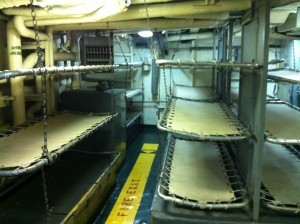
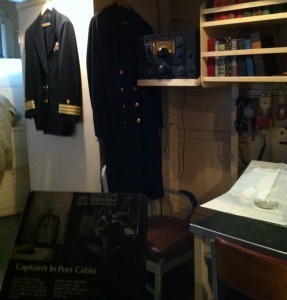
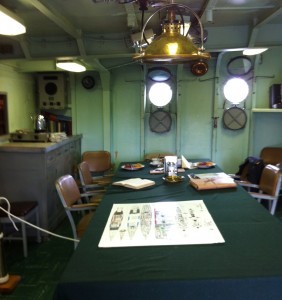
Sailors at Work
Destroyers had a galley (kitchen for us landlubbers), laundry, and offices. In addition to their routine duties, all crewmen also had general quarters duties. The steward would man a gun, and the carpenter’s mate would serve on a repair party.
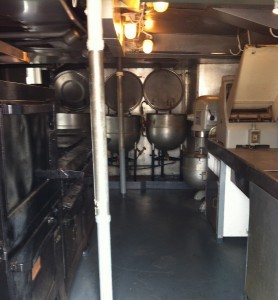

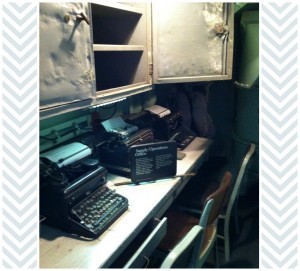
The Bridge
Up in the pilothouse, the captain or the officer of the deck stood watch over the navigation team. The bridge housed the helm (for steering the ship), the engine order telegraph (communicates requested speed to the engine room), a gyrocompass, and other navigational and communications equipment. Later in World War II, destroyers had a Combat Information Center behind the pilothouse, which collected sonar, radar, and communications data to direct battle plans. [Note: pictures below show Vietnam War-era equipment on the USS Joseph P. Kennedy, Jr.]
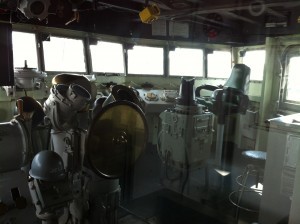
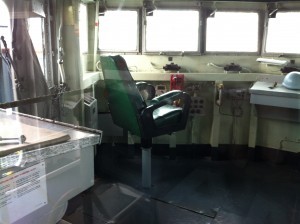
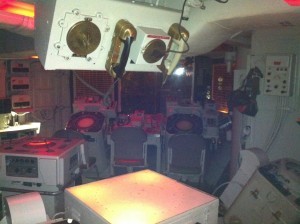
Engine and Boiler Rooms
Deep in the hull lay the engine and boiler (fire) rooms. The WWII-era destroyers had dual sets of boiler and engine rooms, which allowed the ship to maintain propulsion if damaged in combat.
In the boiler or fire room, giant boilers turned water to steam, which was pumped to the engine room. The steam powered the turbines, which turned the propeller shafts. The steam was then pumped to a condenser, sent through a deaerating feed tank to remove damaging gases, and circulated back to the boiler. Fuel oil powered the whole operation.
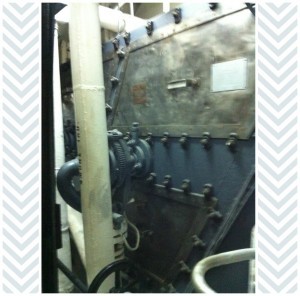
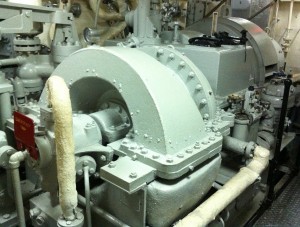
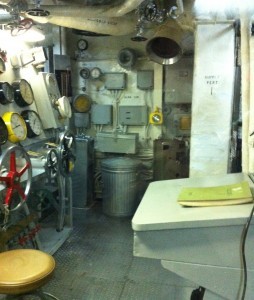
Come back Friday to see the reason for the destroyer’s existence—her armament.
Sources:
McComb, Dave. US Destroyers 1934-45: Pre-War Classes. Oxford: Osprey Publishing, 2010.
McComb, Dave. US Destroyers 1942-45: Wartime Classes. Oxford: Osprey Publishing, 2010.
Wiper, Steve. Warship Pictorial: USS Buchanan DD-484. Tucson, AZ: Classic Warships Publishing, 2009.
Harmon, J. Scott. U.S.S. Cassin Young (DD-793): A Fletcher Class Destroyer. Missoula, MT: Pictorial Histories Publishing Company, 1984.
Friedman, Norman. U.S. Destroyers: An Illustrated Design History. Annapolis, MD: Naval Institute Press, 1982.
Boston National Historical Park: USS Cassin Young. http://www.nps.gov/bost/learn/historyculture/usscassinyoung.htm
Destroyer History Foundation website. http://www.destroyerhistory.org
Tin Can Sailors Website. http://www.destroyers.org/index.html
 Giveaway
GiveawayI’m giving away this vintage Through Waters Deep apron, made by my talented author-buddy Marci Seither, and modeled by her lovely daughter! To enter, leave a comment below (US & Canada only please), on last week’s Tour of Boston, Part 5 article, or on Monday’s Destroyer Tour post. You can earn a maximum of three entries by leaving a comment on each of the three posts. If you can’t leave a comment, please send me an email to enter. Giveaway ends Wednesday, August 5, 2015 at midnight, Pacific Time. I’ll announce the winner here on Friday, August 7, 2015.



